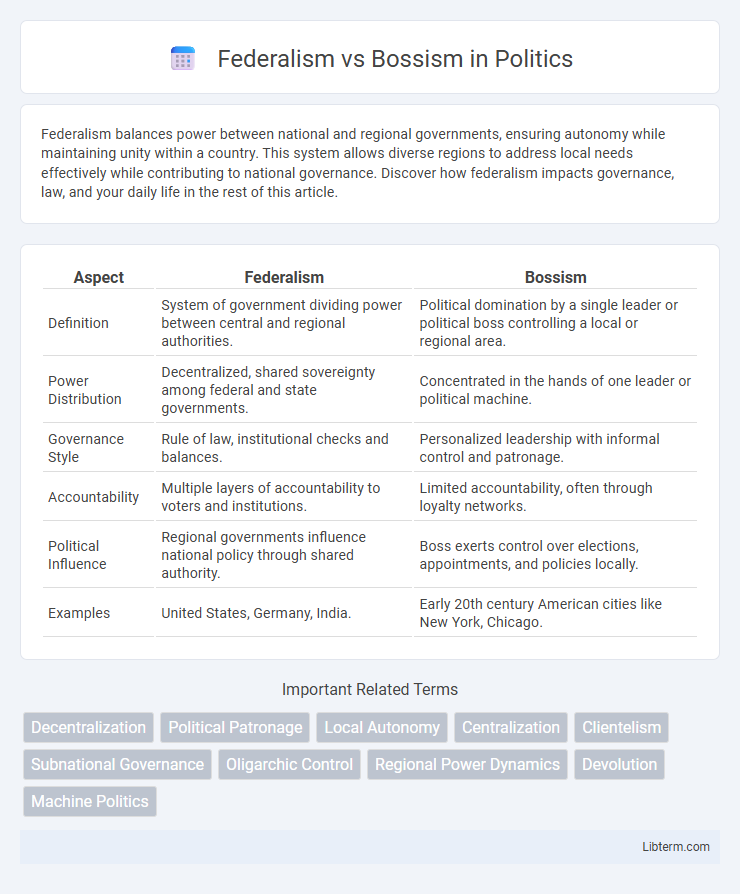Federalism balances power between national and regional governments, ensuring autonomy while maintaining unity within a country. This system allows diverse regions to address local needs effectively while contributing to national governance. Discover how federalism impacts governance, law, and your daily life in the rest of this article.
Table of Comparison
| Aspect | Federalism | Bossism |
|---|---|---|
| Definition | System of government dividing power between central and regional authorities. | Political domination by a single leader or political boss controlling a local or regional area. |
| Power Distribution | Decentralized, shared sovereignty among federal and state governments. | Concentrated in the hands of one leader or political machine. |
| Governance Style | Rule of law, institutional checks and balances. | Personalized leadership with informal control and patronage. |
| Accountability | Multiple layers of accountability to voters and institutions. | Limited accountability, often through loyalty networks. |
| Political Influence | Regional governments influence national policy through shared authority. | Boss exerts control over elections, appointments, and policies locally. |
| Examples | United States, Germany, India. | Early 20th century American cities like New York, Chicago. |
Introduction to Federalism and Bossism
Federalism is a political system where power is divided between a central government and various regional governments, allowing each to have autonomous authority over certain areas such as education, transportation, and law enforcement. Bossism refers to a political structure dominated by powerful local leaders or "bosses" who exercise control through patronage, influence, and often authoritarian means within a specific locality. The key difference lies in federalism's emphasis on balanced governance and shared authority versus bossism's concentration of power in the hands of individual local leaders.
Defining Federalism: Principles and Practice
Federalism is a political system where power is constitutionally divided between a central government and regional entities, allowing for shared governance and autonomy. Its principles include the protection of local interests, decentralization of authority, and legal sovereignty of subnational units within a unified state. This structure contrasts with bossism, where centralized control and personalist political leadership dominate, undermining institutional federal principles.
Understanding Bossism: Origins and Characteristics
Bossism originated in the late 19th and early 20th centuries as a political system dominated by powerful local leaders, or "bosses," who controlled votes and government appointments through patronage and often corrupt practices. Unlike federalism, which emphasizes the division of power between national and state governments, bossism centers on centralized authority within urban political machines that manipulate elections and resources to maintain control. Key characteristics of bossism include strong hierarchical organization, reliance on patronage, and close ties between political leaders and business interests to consolidate power.
Historical Context: Federalism and Bossism in Governance
Federalism in governance refers to the division of power between national and regional governments, enabling localized decision-making that reflects diverse interests within a nation. Bossism emerged in the late 19th and early 20th centuries as a form of political control exerted by powerful local leaders or "bosses," often within urban political machines, who manipulated patronage and voter loyalty to maintain authority. Historically, federalism sought to balance power across different government levels, while bossism concentrated power in individual leaders, sometimes undermining democratic processes through corruption and coercion.
Political Structures: Decentralization vs Central Control
Federalism emphasizes political structures based on decentralization, granting constituent states or regions significant autonomy in governance, law-making, and resource management. Bossism concentrates power through central control, where political bosses dominate decision-making, often undermining democratic processes and local self-governance. This contrast highlights federalism's preference for a balanced distribution of authority versus bossism's top-down, authoritative political system.
Impacts on Local Governance and Democracy
Federalism promotes decentralization by distributing power among various levels of government, enhancing local governance autonomy and accountability. Bossism undermines democratic principles by concentrating control in local political machines or single leaders, leading to corruption and reduced citizen participation. The contrast between federalism's support for pluralism and bossism's tendency toward authoritarianism significantly shapes the quality and effectiveness of democratic local governance.
Economic Implications: Resource Allocation and Development
Federalism promotes equitable resource allocation by granting regional governments fiscal autonomy, fostering localized economic development tailored to diverse needs. Bossism centralizes economic control under a dominant leader, often leading to skewed resource distribution favoring political allies and hindering balanced growth. This concentration of power in bossism can suppress competitive markets, while federalism's decentralized model encourages innovation and efficient public investment.
Social Consequences: Representation and Accountability
Federalism enhances representation by distributing power across multiple government levels, allowing diverse communities greater input in policymaking and fostering accountability through checks and balances. Bossism centralizes authority in political bosses, often reducing transparency and limiting citizen influence, which can lead to autocratic practices and weakened public accountability. Social consequences include diminished political participation and increased corruption under Bossism, whereas Federalism promotes democratic engagement and responsive governance.
Case Studies: Examples of Federalism and Bossism in Action
Federalism is exemplified by the United States, where power is constitutionally divided between national and state governments, allowing states to enact policies tailored to local needs, such as California's environmental regulations. Bossism is illustrated by late 19th-century New York City under Boss Tweed, where political machines controlled city governance through patronage and corruption, prioritizing loyalty over democratic processes. These case studies highlight federalism's emphasis on decentralized governance contrasting sharply with bossism's centralized political control and manipulation.
Conclusion: Weighing the Pros and Cons
Federalism enables localized decision-making, promoting diversity and regional autonomy while potentially causing inconsistencies and fragmentation in governance. Bossism offers streamlined authority and swift decision execution, yet risks concentrating power, reducing transparency, and undermining democratic accountability. Balancing federalism's pluralism with bossism's efficiency requires careful consideration of political context and institutional safeguards.
Federalism Infographic

 libterm.com
libterm.com